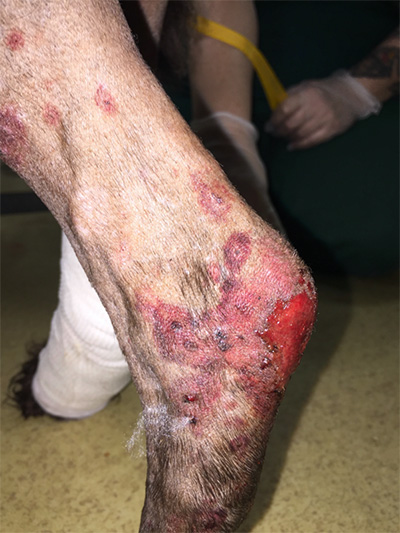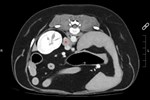Cutaneous and renal glomerular vasculopathy a.k.a. ‘Alabama rot’ in the UK – Frequently asked questions
What is the disease?
The condition was first reported exclusively greyhounds in America during the 1980s and has been seen in a single dog in Germany in 2002 before emerging in multiple different dog breeds within the UK from 2012 onwards. Based on skin and kidney samples taken from affected dogs the disease is classified as a thrombotic microangiopathy - that is, a disease in which blood clots form in the very smallest blood vessels within the body. The locations of these clots gives us the characteristic clinical signs of skin lesions and kidney injury. Other organs can also be affected such as the brain.
What should I look out for?
Dogs affected by CRGV typically present with non-traumatic skin ulcers on their digits, pads, paws or feet although some dogs have shown ulcers(s) on their head, muzzle, tongue, flank and belly. The ulcers vary in severity and can look as simple as a small cut or area of redness that could be mistaken for a cut pad, bruise or sting. It is important to remember that most skin ulcers will not be caused by CRGV.

In some dogs the skin ulcer is the only sign that develops and these dogs can make a full recovery without developing kidney problems. However, some dogs will develop kidney failure. This typically occurs within 1-9 days of first noticing the skin ulcer(s). Signs to be concerned about would include lethargy, decreased appetite, nausea, vomiting, increased thirst or decreased urination.
If your dog develops an unexpected skin ulcer it is recommended that you seek veterinary advice.
How do I stop my dog from getting CRGV?
Unfortunately, as the cause of CRGV is unknown, it is difficult to give specific advice on prevention. Bathing the feet and legs of dogs after a walk is often recommended, and while there is no evidence to prove this is of benefit it would allow more rapid detection of skin lesions in the most common areas.
Where should I walk my dog to avoid CRGV?
Initially cases appeared localised to the New Forest area. However, this is no longer the case and dogs suspected or confirmed to have CRGV have come from all over the UK. Although an environmental cause for this condition has not been excluded and some research has found higher associations with certain types of environments (such as some woodland types), currently, there are no recommendations to avoid walking your dog in particular areas.
For the latest information on distribution of cases please go to https://www.alabama-rot.co.uk
How common is CRGV?
Between November 2012 and February 2024 there have been 318 confirmed cases of CRGV. Confirmed cases are those who have died and in whom a post-mortem diagnosis of CRGV has been made. The number of dogs who develop CRGV and survive is not fully known, and all data will be skewed towards the most severely affected dogs. Confirming a diagnosis of CRGV without biopsy of the kidneys is not possible, meaning all surviving dogs have been diagnosed based on consistent clinical signs. As of March 2024, approximately 30% of dogs clinically diagnosed with CRGV at the Royal Veterinary College’s Queen Mother Hospital for Animals have survived but this number should be interpreted with care as a different population of cases will present to referral centres compared to general practitioners. A seasonal distribution is reported with most cases occurring between November and May each year. It is important to remember that compared to other problems that we see in dogs, this is still an exceedingly rare condition.
What type of dogs are affected by CRGV?
Unlike the early reports which affected greyhounds, cases of CRGV in the UK have affected dogs of many different breeds, both large and small and of any sex and with a wide age range. There have been reports of multiple dogs from the same household being affected by CRGV.
What is the treatment for CRGV?
Unfortunately, because the underlying cause of CRGV is still unknown there is no specific treatment. Depending on the severity of the skin ulcer and level of suspicion for CRGV, your veterinary surgeon may recommend treatment for the skin ulcer and monitoring of kidney function with blood and urine tests. For dogs that develop kidney problems then it is likely that supportive treatment will be required for your dog in the hospital and your vet may recommend referral to a specialist. At the RVC’s Queen Mother Hospital for Animals advanced supportive care options including plasma exchange are available and may be considered for dogs with CRGV in specific circumstances. We would be pleased to discuss these options with your veterinary surgeon and would ideally discuss these at the first consideration of CRGV, as treatment options become more limited as the disease progresses. We recommend the avoidance of non-steroidal anti-inflammatory drugs (NSAIDs) in animals with clinical concern for CRGV given the potential renal impact in dogs with the disease.
Can other animals be affected?
To date there are no reports of animals other than dogs being affected and no illness has been reported in humans or owners of affected dogs.
How can I help and what research is on-going to help us understand this condition better?
To improve the diagnosis and management of patients with CRGV it is vital that research is performed to understand what causes this condition and whether there are any environmental or lifestyle factors that influence the disease. To facilitate this there are several studies which are ongoing at the Royal Veterinary College of which some are in conjunction with colleagues at Anderson Moores Veterinary Specialists. Research is costly both in terms of time and finance, therefore one of the ways that you can help us fight this condition is to consider fund-raising or donations to help support this work. For general practitioners, Anderson Moores veterinary specialists offer a free of charge histopathology serve for renal and skin tissue for suspected cases and we encourage veterinary surgeons to contact them for more information.
Fundraising:
Donations can be made to the Animal Care Trust.
The Alabama Rot Research Fund (ARRF) is a national charity aiming to raise awareness and funds for Alabama Rot (CRGV) research.
You may also be interested in:
-
New RVC study reveals breed predispositions and risk factors for rare adrenal tumour in dogs
Novel research from the Royal Veterinary College (RVC), in collaboration with the Faculty of …

